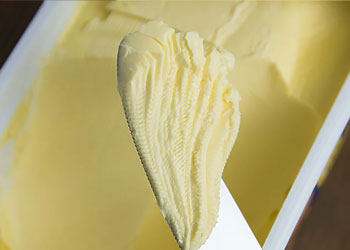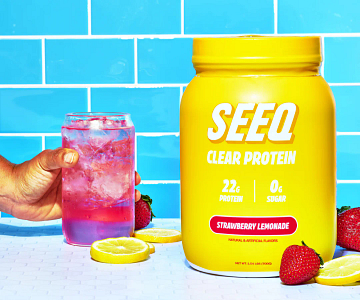- Fact Checked
Last Updated: December 4, 2020
We hate to break it to you, but that’s not always the case. While most types of modern margarines cut the mustard in terms of their vegan-friendliness, others are sneaky and may contain some animal-derived ingredients.
But don’t worry, you don’t need superpowers to be able to tell the difference, we’ll arm you with useful information that can help you choose the right kind of plant-based margarine to match your healthy diet.

According to the definition, which many vegans tend to take for granted, margarine is an alternative to butter that is made of vegetable oil instead of animal-sourced fat.
It’s a seemingly straightforward answer, right?
Well, being the chameleon in the world of bread spreads, the ingredients used for margarine and its production went through various phases and changes throughout history and that’s where the confusion probably comes from.
[thrive_leads id=’11437′]
Although this method varies depending on the manufacturer, production of margarine usually requires water or skimmed milk, salt, lecithin, flavouring, coloring agents, and of course, vegetable-derived oils.
The next step is oil hydrogenation, that dirty word that makes most people freak out for no good reason.
Hydrogenation raises the melting point of oil, which allows margarine to remain solid but still easy to spread at room temperature. This process involves adding hydrogen molecules to fatty acid chains to produce so-called ‘’saturated” fats and remove unsaturated or trans fats [1].
Trans fats are notorious for their role in heart and vascular diseases and that’s why it’s crucial that the hydrogenation process is done properly to prevent ‘’partial hydrogenation” that produces these harmful fats [2].
Our guess is that this is partially due to a lack of knowledge and the rest is just bad marketing.
You’ve probably heard that rumor that margarine and plastic have almost the same composition? Well, according to scientific evidence, that is only seemingly true [3].
Some myths and legends about margarine are hard to shake, but let’s go back to the beginning.
Margarine was formulated in the mid 1800s as a poor man’s replacement for butter and was originally made from low-quality animal fat.
In the 20th century its improved vegetable-based version gained popularity as it was advertised as being lower in saturated fat than butter. However, soon after it was discovered that it was high in unsaturated trans fats coming from hydrogenated vegetable oils, margarine became the villain yet again.
Luckily, in the late 2000s, most countries, including the US, set the limits on trans fats in processed foods, including butter substitutes, so instead, most modern-day margarines are packed with mono- and polyunsaturated fats that are actually good for your health [4].
Back to the essentials. Making sure that your margarine is indeed vegan doesn’t have to be a challenge, just stir clear from the following ingredients when choosing your next vegan margarine.

If you’re worried that your hot piece of toast will be left bare, you shouldn’t be – plenty of healthy options and different brands of vegan margarine will have it covered.
One such brand that you can start from is Earth Balance that offers a variety of dairy-free options, from olive oil, to the avocado-sourced alternative to butter, to coconut and buttery-like vegan spreads.
Plus, you can also get dairy-free baking sticks to enjoy your homemade vegan pastries and other treats.
One of their best-sellers, which is highly rated among a number of fellow vegans out there, is European Style Buttery Spread that has that wonderful buttery texture and taste, minus all those harmful fats and preservatives.
All products coming from Earth Balance are non-GMO and 100% plant-based.
There are also other good vegan & dairy-free margarine products like Smart Balance Original Buttery Spread and Blue Bonnet Soft Spread.
For vegans who are into do-it-yourself projects, there is a plethora of easy and delicious vegan butter recipes. The best thing of all is that you won’t need to speculate about the ingredients as you indulge in your guilt-free vegan butter.
Variations are endless, but the most common ingredients include refined coconut oil, almond flour, which acts as an emulsifier, non-dairy milk, nutritional yeast, salt, and some apple cider vinegar. You can use olive oil, canola, or avocado oil for better texture and spreadability.
To disguise the pale white color, add a pinch of turmeric to make it yellowish, and voila – your homemade vegan margarine is ready!
Not only does it taste heavenly on a piece of warm bread, but it’s also a decent competitor of factory-made margarine in baking.

Vegan or non-vegan, the content of fat in margarine is what makes it a type of food that should not be served three times a day.
Most margarines on the market contain 80% fat, just like regular animal-sourced butter or shortening like Crisco.
Vegan margarine that contains healthy plant-sourced oils instead of animal fat might be great for your heart, but it is still high in calories.
Many brands of margarine are also made with the addition of omega-3 acids and vitamins to make them healthier.
Although the use of hydrogenated oils is not entirely a thing of the past, it is getting less common, many brands are changing the game and, hopefully, the reputation of this popular product.
So, is margarine vegan? Most margarines are, but you should still double-check the list of ingredients on your butter substitute to make sure it fits your diet.
Basically, the only way to have your bread buttered on both sides is to make your own vegan margarine, also known as ‘’vegan butter”, or go for some trustworthy vegan margarine brands.
[thrive_leads id=’11437′]
Reference


Address: 1300 Avenida Vista Hermosa, San Clemente, CA 92673, United States | Phone Number: +1 (949) 248-0131 | Email: contact@veganliftz.com